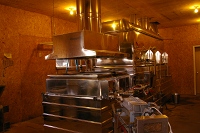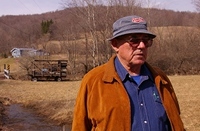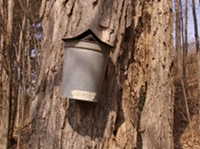The Watershed Post interviews George and Duane LaFever, Catskill maple syrup producers.
It's the peak of New York's annual maple festival, and local tappers are saying the maple syrup yield in the Catskills is worse than it's ever been.

"It's pretty universal in the Catskill region that you're just doing lousy," she says.
Jessica Ziehm, a spokesperson for the New York State Department of Agriculture & Markets, confirms that because the Catskills are the southernmost syrup-producing region in the state, they "might be a little worse-off than others." But it's been a bad season for syrup all over, she adds.
At Catskill Mountain Maple, a sugar house in Delancey, 74-year-old George LaFever, a second-generation syrup-maker, says that this is the worst maple season in memory.
"It's been a horrible season," says his son, Duane LaFever, who owns Catskill Mountain Maple with business partner Tom Kaufman. "We're probably at maybe 25 percent of normal."

This winter's intense blizzards, which have been chased by freakishly early warm weather, are probably playing a role, says Thomas, who spoke with the Watershed Post by phone as she was cleaning her sap lines in an attempt to boost her own forest's yield.
"The nights have gotten way too warm way too fast," she says. "It's supposed to warm up slow. That way the trees wake up slow."
"We haven't had the freezing nights," Kaufman says. "And it seems like when we have had the freezing nights, it's still going wrong."
But there might be another factor at play: the forest tent caterpillar, or as George LaFever calls them, "maple worms."
Forest tent caterpillars eat leaves and can kill trees. Cornell's Sugar Maple Research & Extension program advises maple producers to spray for them if the defoliation is bad enough to hurt sap production. Kaufman says he has sprayed for tent caterpillars three times in recent years.

There are plenty of other pests that enjoy munching on maple trees. The gypsy moth caterpillar, which has plagued the Northeast since it was introduced deliberately in 1869, has boom-and-bust population cycles that take a fierce toll on Catskills forests. Google turns up something called the greenstriped Mapleworm, along with a bunch of other wormlike maple pests. There is also a maple borer, which, though not a worm, does infest maple trees. The maple sugar industry is also threatened by the advancing Asian Longhorn beetle, which can only be eradicated from a forest by burning the infected area to the ground.
Whatever the cause of the shortage, this year might be one for the record books.
"It's a little heart-breaking," Ziehm says.
Update: A maple expert gives us some possible reasons for the shortage.















